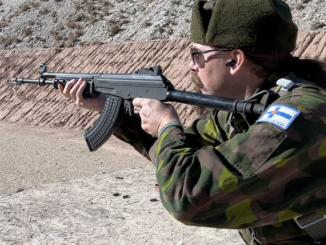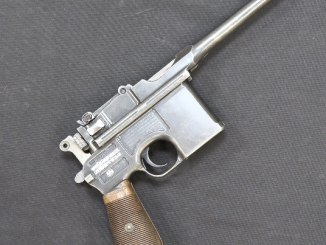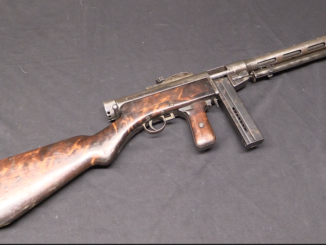Asked by Prmetime on Utreon: In WW2, Finland was given approximately 100,000 Carcano M38 rifles in 7.35 Carcano. I have heard it stated that the Finns didn’t like the rifles. Can you comment on the veracity of that statement, and if true, do you know why they weren’t liked?
The Finnish government began negotiating with Italy to purchase available 7.35mm Carcano rifles in January of 1940, and ultimately concluded a deal to get 100,000 of them, complete with slings and bayonets. The rifles did not arrive until the summer of 1940 (after the Winter War had ended), but they rifles were put to use in the Continuation War. They were primarily issued to troops unlikely to need rifle, including the artillery corps and Air Force – although some did get issued to front line infantry. In addition, many were distributed to civilians along Finland’s eastern border to offer some protection against Soviet partisan attacks on villages.
The rifles (generally called “Ternis” in Finland after one of the manufacturers) were indeed strongly disliked. This can be traced to both inconsistent ammunition and the fixed rear sights. Finnish rifle development had focused heavily on improving the sights on their Mosin Nagant rifles to allow very precise shooting, and the M38 Carcano was the polar opposite, with a fixed V-notch rear sight. The ammunition did not always shoot to point of aim, and the sights could not be adjusted for range. These factors together led to an immediate distaste by Finnish troops. The guns were often discarded in favor of captured Russian rifles, which offered more power, more familiarity, and the use of standard Finnish ammunition.
By the end of the Continuation War about 20% of the Carcanos had been lost or destroyed, and the remainder were put into storage. In 1957 they were all traded to InterArms for Sten guns, and were subsequently sold on the American collector market.




Is it possible the Carcano Model 38 carbine used in the JFK assassination was one of those purchased by Finland and later sold to Interarms? Or were the Finnish Carcanos only the full-length rifle model?
The one Oswald used was a 6.5 M91/38. The Finns received 7.35 M38.
So, I just had a question that popped into my brain when I was watching your older video about the Japanese Type 100 Arisaka Paratroop Rifle, my question was “why not just use a bent bolt handle” when you were talking about the removable bolt handle that rifle had. Anyway. the question evolved into “why didn’t every rifle of that era have a bent bolt handle?” It may be trivial (I’m not super familiar with firearms though I think their cool), but bent down bolt handles seem like they’d be easier for storage purposes as well as convenient to carry, and more ergonomic for soldiers to actually use. I know the British, French, Americans, and Germans had it as standard on their bolt actions at the start of WW2, so why not the Russians, Italians, and Japanese? (With the exception of sniper variation of the Mosin, or the M38 Carcano of course).
“(…)bent down bolt handles seem like they’d be easier for storage purposes as well as convenient to carry, and more ergonomic(…)”
Benting is additional action during production which does increase cost and Mosin rifle was from very beginning destined to produced a lot to equip vast forces of CZARDOM OF RUSSIA, whilst SMLE and M1903 were adopted when land forces of UNITED KINGDOM and UNITED STATES OF AMERICA were quite small in relation to their population.
They were standard in Carcano carbines (Cavalry and TS) too since the start of production, for the same reason they were carbines, easy of transport for troops (Artillerymen, engineers…) that had other things to do.
Not standard in infantry rifles because straight handles give better leverage in case the action, for whatever reason, is hard to open.
Oops! I’ll answer my own question. No. Oswald’s Carcano was never in Finland and did not enter the secondary market through Interarms. His gun was sold by the Italian Army to Adams Consolidated Industries who sold it to Klein’s Sporting Goods.
As I recall, Ian used a fixed-sight Carcano in a two-gun match on the theory that the fixed-sight was a good practical solution for a bolt-action infantry weapon in WWII, and got thoroughly trounced by Karl using a KAR 98 with a conventional range-adjustable rear sight. Did he discover the Finns’ complaint firsthand?
Mr. M got trounced because he shot a standard bolt-action gun left-handed and jammed the bolt open with unpracticed handling. If Ian and Karl had then traded rifles and run the match we would have had a fairer insight into the actual practicality of the M35. However, if I recall correctly, the supply of 7.35 ammunition was limited.
Ian had problems actuating the safety while cycling the action I’ve never seen anyone else have. Probably a worn out sample.
Followers of Drachinifel the naval historian will know that the Italians had problems manufacturing consistent ammunition right up to their 15″ naval shells. That World War II “broke out for” Italy is debatable: though Mussolini had an alliance with Hitler, Italy was technically neutral (despite the Ethiopian incursion) right up to June 10, 1940, when Mussolini declared war on France and opportunistically invaded, with an eye on turning around and picking on Greece too. Some of those Interarms Carcanos didn’t just go to the “collector’s market,” a number of them must have gone to hunters, such as my father, who bought a 7.35 Carcano for twelve dollars or so and sporterized it at home. This was purchased at the same sporting goods store in Chicago from which Lee Harvey Oswald mail-ordered his 6.5 Carcano. Dad’s 7.35 (and ammunition) were sold off before this channel was founded, so I can’t tell you for sure if it was an Interarms import from Finland.
The only source for the problem with naval shells was Adm. Iachino, that had to justify his fiasco at Cape Matapan, and had been debunked by other sources, IE Adm. Emilio Brenta. As a matter of fact, the Italian 152mm and 203mm are the only Cruiser naval guns that obtained some +20km hits during WWII.
Oh well, opinions will differ. Here’s Drachinifel with some Italian historians:
https://www.youtube.com/watch?v=A8YG_VA4aYA
“(…)technically neutral(…)”
Is that English translation of NON BELLIGERANZA which was declared by KINGDOM OF ITALY https://www.treccani.it/enciclopedia/non-belligeranza_(Enciclopedia-Italiana)/ ?
I don’t know. Mussolini had signed an alliance with Hitler but did not involve himself in the European land war until after France was invaded by Germany, and looked like she would lose.
Finland received 7.35x51mm Carcano rifles and carbines from fascist Italy to use against the Red Army. The Winter War/ Talvisota took place between Dec. 1939-Mar. 1940 when the USSR and Germany were basically allied via the Molotov-Ribbentrop Pact. Western Powers and future member of the tripartite pact, Italy [September 1940] sympathized with the refusal of Finnish leaders to accede to Soviet territorial demands, rejection of their ultimatum, etc. and so sent lots of military equipment, much of it distinctly “second-hand” in nature. Much of that military equipment, aircraft, weapons, etc. arrived too late to see use in exacting a toll on the Russian invader, but was on hand when Finland’s “war of choice” or the Continuation War began just after the German surprise attack against the USSR in June 1941.
Italy had been half-way through a caliber change designed to re-bore the 6.5x52mm Carcano and the suite of infantry weapons, hence the 7.35mm caliber. This change was undertaken instead of adoption of spitzer bullets or more modern bullet designs for the 6.5mm. Late in the game, the Italian armed forces decided the change should be stopped in light of imminent Italian participation in WWII, and so the arms in that larger caliber “intermediate cartridge” of sorts were off-loaded for the most part.
Finns may have groused about the Italian rifles and carbines, but grateful for the FIAT G.50 Freccia aircraft, Beretta pistols, M33 steel helmets, and AT guns…
I love yinz “War of Choice” guys. Because why would they want their own land back, and maybe with a little revenge for desert? Winston Churchill knew what Stalin was and would have loved to help Finland. Remember this about the Eastern front. There were no good guys. Two murdering socialist dictators who both wanted to rule all of Europe with an iron fist. National Socialist, (nazi), or International Socialist, (commies), the difference means little when you and your whole family is about to get executed.
The feeling was mutual. “It’s cold up here and nobody can make a decent bowl of pasta!”
Funnily enough, one Silvio Berlusconi made a series of disparagements about Finnish cuisine and food, so the KOTI Pizza chain developed a “Berlusconi pizza” with reindeer meat, chanterelle mushrooms, and even put some rye in the crust…
https://www.finnstyle.com/pizza.html
I’ve eaten it, and it is delicious.
“(…)guns were often discarded in favor of captured Russian rifles(…)”
https://www.jaegerplatoon.net/RIFLES6.htm shows photo labelled Photograph showing collection point for captured rifles in Räisälä (in Carelian Isthmus) in August of 1941. Organizing such collection points after battles was apparently normal. In addition to Soviet rifles the the pile contains at least eight Italian M/38 rifles, which must have been left behind when the soldiers that had been issued one traded them in for captured Soviet rifles. Photographed by 2nd Lieutenant L. H. von Willebrand
Also whilst With the rifles Italy delivered also 50 million rounds of 7.35 mm x 51 ammunition, which proved to be plenty for rest of their service career in Finland. this weapon requires clips whilst Mosin allows chargers and partially deplete magazine might be filled using loose cartridges https://www.youtube.com/watch?v=OlZU80cLoOA
Did Finns used any other weapon requiring usage of clips (not chargers) during Talvisota?
Mind that the Carcano ammos were already packed into the clips. There was not way to have the ammos without the clips. If you have a “partially depleted magazine” it means that you have more clips than ammos.
http://imagizer.imageshack.us/v2/800x600q90/822/6u1ex.jpg
With the Carcano, if you have a partially depleted magazine and what to have a full one, you can eject the partially depleted clip (you don’t have to cycle, there’s a button) and insert a new one. The partially depleted one will be stored in the pocket, to be used later, or filled with another partially depleted one. All faster than inserting loose cartriges one by one.
In my experience the Italians had by no means any difficulty to produce adequate ammunition. As far as 7.35 mm is concerned, all cartridges I have seen (several hunddred) were in a pristine condition. Those disassembled had bullets good quality and totally normal weight tolerances. Muzzle velocity was as advertised and did not shown any undue variation.
The clip is a non-problem, because all ammunition I have seen came in clips.
The fixed 200 m sight of the M38 rifle is in my view based on a sober assessment of what the typical soldier can achieve in battle. My run of the mill 7.35 mm rifle shoots at least as well as an AK in single fire. Its bolt runs at least as smooth as my Canadian No. 4.
I am afraid a negative attitude of the Finns towards the Carcano, as so often happens in any military organizations, is more a product of prejudice than actually seeing for oneself what it really can do or not do on the range.
Well said.
The Carcano M38 pretty much is across the grain to what Finns were used to. There was lots of sports shooters and hunters in Finnland and the M38 was built for your average guy barely able to shoot straight. Then the weird non standard ammuniton for it, which I bet was hard to get at times. Whereas 7,62*54 mmR was ubiquitous and a Mosin-Nagant rifle of any type had adjustable sights more fitting to finnish preferences as well. The M38 really was an odd duck in the suomi arsenal. Hence the dislike from Finns.
The issue many Finnish soldiers had with the fixed sights was not just that they were fixed, but also the 200 meter range. While it would not seem like a significant issue based on the ballistics alone, the soldiers felt that it made difficult to hit prone targets at about 100 meters and would lead “overshooting” the target. Therefore many Carcanos had their front sights raised as a field modification (something Ian doesn’t mention), which changed the zero to somewhere around 100 to 150 meters. There were even plans to change the rear sight to something similar to the M39 Mosin-Nagant, but those were never realized due to cost.
Whether there was ever any actual practical reason for the front sight modification is another matter. The Carcanos never went through any kind of formal evaluation in Finland and any all their supposed flaws were based on individual soldiers’ experiences on the field, which may have very well been product of prejudice as you say, rather than based on any objective truth about the weapons. The Carcano was, after all, quite different from the Mosin-Nagant. There may have also been some prejudice towards Italian industrial products in general, which were not as well known to the people as for example German or British products.
The issue may have been that the Finns weren’t average soldiers but mostly marksmen
I’m wondering how often in battle the sights on the various models of Mosin-Nagant rifles were actually adjusted? I mean, in Russian practice, later Soviet, and presumably, also Finnish practice, the M91 is set at “4” for 400 meters, and the 1891-30 rear sight is set at “3” for 300 meters, and in instances where the range remains unclear or unknown, and the situation is, shall we say, “fluid” holding low–aiming at the thigh-level of enemy soldiers–would result in a disabling torso hit. If officers and NCOs or soldiers more adept at estimating range called out the range and were able to be heard above the din, then soldiers were supposed to adjust the sights accordingly, but realistically, I think it was usually held at 300 meters, and soldiers were instructed to aim under the target…
Civil Guardsmen undoubtedly were well used to marksmanship, as were very many soldiers, but then again, there were lots of factory workers, farmers, etc. mobilized who may not have had much by way of instruction, no?
Over the years I have seen a few M38s with the rear sight milled off and dovetail for a Williams, Lyman or Marble’s folding single leaf replacement rear sight -all of which are adjustable designs
Ian: There was never a company called “InterArms”. It was “Interarms.” Earlier, back in the sixties when the Carcanos were imported, the d/b/a was “Interarmco”, an aggregation of “International Armament Corporation”– but Armco Steel brought suit for trademark infringement, so the d/b/a was changed.
M
I reload for the 7.35mm Carcano rifles, for both the carbine and the M38. They are handy, light, and reliable in the field. It is an overstatement to use harsh words, the Finns needed the Carcano for certain units that eventually were forced to fight such as artillery during midnight raids. Moreover, many captured Russian M91/30 rifles were rebuilt to Finnish standards but never issued. Reality may be complex under difficult circumstances.
I have an M38 in 7.35mm. I does not shoot to POA with surplus ammo, but after figuring “Kentucky windage”, I was able to hit a 2′ gong with every shot at 200yds, offhand.